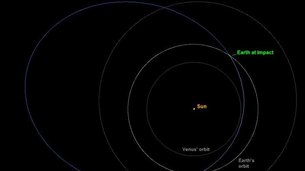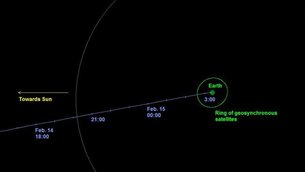
An object entered the atmosphere over the Urals early in the morning of
15 February 2013. The fireball exploded above Chelyabinsk city, and the
resulting overpressure caused damage to buildings and injuries to
hundreds of people. This photo was taken by Alex Alishevskikh from about
a minute after noticing the blast. CC BY-SA 2.0 via Flickr.
The first firm details of the 15 February
asteroid impact in Russia, the largest in more than a century, are
becoming clear. ESA is carefully assessing the information as crucial
input for developing the Agency’s asteroid-hunting effort.
At 03:20 GMT on 15 February, a natural object entered the atmosphere and disintegrated in the skies over Chelyabinsk, Russia.
Extensive video records indicate a northeast to southwest path at a
shallow angle of 20° above the horizontal. The entry speed is estimated
at around 18 km/s – more than 64 000 km/h.
According to calculations by Peter Brown at the University of Western
Ontario, Canada, drawing on extremely low-frequency sound waves detected
by a global network, the object is estimated to have been about 17 m
across with a mass of 7000–10 000 tonnes when it hit atmosphere.
It exploded with a force of nearly 500 kilotons of TNT – some 30 times
the energy released by the Hiroshima atomic bomb – around 15–20 km above
the ground.
With our current understanding of near-Earth objects, events of this
magnitude are expected once every several of tens to 100 years.
 (42.28 kB
(42.28 kBThe estimated orbit around the Sun of the Chelyabinsk object. It illustrates the orbits of Venus, Mars and Earth, together with the Sun and Earth at impact. The illustration is based on data provided by Dr Peter Brown.
Nicolas Bobrinsky, Head of ESA’s Space Situational Awareness (SSA) programme, and Detlef Koschny, responsible for the programme’s Near-Earth Object activity, responded to questions about the event.
Was this event related to the predicted flyby of asteroid 2012 DA14, which passed Earth at 19:27 GMT that same day at just 28 000 km?
DVK: The trajectory, the location of entry into the atmosphere and the large time separation between the two events indicate that the Russian object was unrelated to 2012 DA14.
What caused the damage on the ground? Did pieces hit people or buildings?
DVK: Many media reported that an airburst caused window breakage and some structural damage in downtown Chelaybinsk. Normally, some damage begins to occur at around five times normal air pressure at sea level. Widespread window damage is expected around 10–20 times this value.
As the explosion and fireball progressed along a shallow trajectory, the cylindrical blast wave would have propagated directly to the ground and would have been intense.
The terminal part of the explosion probably likely occurred almost
directly over Chelyabinsk. This was perhaps the single greatest
contributor to the blast damage.
We are waiting for confirmation from the Russian authorities that pieces of the object – bits of meteorite – have been found in the region. We’re unaware of any media reports of anyone or any structure being hit by any debris from the object itself.
We are waiting for confirmation from the Russian authorities that pieces of the object – bits of meteorite – have been found in the region. We’re unaware of any media reports of anyone or any structure being hit by any debris from the object itself.
Hide continue
The approximate final trajectory of the Chelyabinsk object, from 18:00 GMT 14 February to 03:00 GMT 15 February. The illustration is based on data provided
by Dr Peter Brown.
Have there been similar events in the past?
DVK: Yes. Perhaps the most famous recent one is the 1908 Tunguska event, in which a large meteoroid or comet fragment, thought to be in the order of 40 m in size, exploded at an altitude of 5–10 km. It’s the largest in recorded history, although many, many larger impacts are known from geological history.
On 12 February 1947, the Sikhote-Alin event in the former Soviet Union involved an iron object, which meant that much of its 10 kilotons TNT of energy was deposited in the ground rather than in the air like last week.
On 8 October 2009, a body generated an atmospheric fireball blast similar to last week's event over an island region of Indonesia. Its energy was about 5 kilotons.
What are the risks of a similar event happening in the future?
DVK: Near-Earth Objects (NEOs) are asteroids or comets with sizes ranging from metres to tens of kilometres that orbit the Sun and with orbits that come close to Earth’s.
Currently, there are over 600 000 asteroids known in our Solar System; more than 9000 of these are NEOs. Once an object is discovered, its orbit can be calculated and an individual risk profile developed for that object. ESA maintains a public list of these via http://neo.ssa.esa.int/web/guest/risk-page.
How is ESA's SSA team receiving information?
DVK: Like NASA and other national space agencies, ESA maintains close contact with government-level technical and scientific information-sharing bodies. The information is also discussed within government-level bodies. We also work closely with NEO teams at NASA and European national space agencies.
What is a possible scenario for an asteroid warning?
DVK: A very good example is the case of 2008 TC3, an 80-tonne, 2–5 m object that hit the desert in Sudan on 7 October 2008. It was very small and was spotted by chance only 20 hours before it hit. Initial, rough observations gave a possible impact zone over 2000 km long. Within hours, this had been refined to an area of just the Sudan desert.
In a similar case in the future, civil authorities would be able to tell the population in the narrowed-down area to stay away from windows, glass or other structures and stay indoors. The risk that an airburst and resulting over-pressure would cause personal injury by fractured glass or a flimsy structure would be significantly reduced.
DVK: Like NASA and other national space agencies, ESA maintains close contact with government-level technical and scientific information-sharing bodies. The information is also discussed within government-level bodies. We also work closely with NEO teams at NASA and European national space agencies.
What is a possible scenario for an asteroid warning?
DVK: A very good example is the case of 2008 TC3, an 80-tonne, 2–5 m object that hit the desert in Sudan on 7 October 2008. It was very small and was spotted by chance only 20 hours before it hit. Initial, rough observations gave a possible impact zone over 2000 km long. Within hours, this had been refined to an area of just the Sudan desert.
In a similar case in the future, civil authorities would be able to tell the population in the narrowed-down area to stay away from windows, glass or other structures and stay indoors. The risk that an airburst and resulting over-pressure would cause personal injury by fractured glass or a flimsy structure would be significantly reduced.
On 15 February, a large fireball was reported over Chelyabinsk, Russia.
- Time of impact: 03:20:26 GMT
- Location: 55° 10' N, 61° 25' E
- Entry angle: 20º above horizontalº
- Entry speed: below 20 km/s
- Trajectory: northeast to southwest
- Asteroid diameter before entry: about 17 m
- Kinetic energy: 500 kt TNT equivalent, corresponding to 30 times the energy of the Hiroshima bomb
- Explosion altitude: 15–25 km
NASA
Guillermo Gonzalo Sánchez Achutegui
ayabaca@gmail.com
ayabaca@hotmail.com
ayabaca@yahoo.com
Inscríbete en el Foro del blog y participa : A Vuelo De Un Quinde - El Foro!



No hay comentarios:
Publicar un comentario